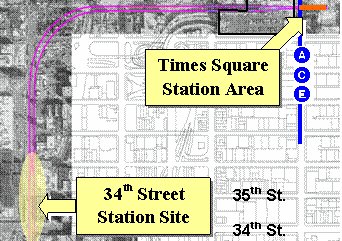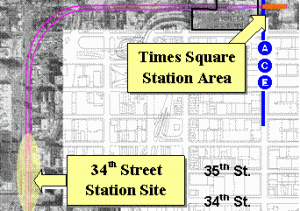Tracking NYC’s Transit Development Projects
By Danielle Schlanger October 9, 2014 6:00 am
reprints

Transportation and real estate development work symbiotically; development plans are largely centered around transit hubs, while transportation lines exist to shuttle people to and from high-density areas.
“Mass transportation is crucial for the economic vitality of our city,” said Michael Slattery, the senior vice president of research at the Real Estate Board of New York. “It carries people to their jobs, to their homes, and connects them to the cultural and social life of the city. An expanding mass transit system can promote the growth of underutilized areas and enhance and revitalize the entire metropolitan area.”
However, transportation development projects have historically struggled to stay on-schedule and on-budget. With the end dates of a handful of high-profile projects in sight, Commercial Observer has chosen to examine six public works projects, their estimated timetables and how closely they stuck to their initial budgets.
Second Avenue Subway
Groundbreaking Date: April 12, 2007, though The New York Times reported that there had been at least four previous groundbreakings for the subway for construction done in the 1970s.
Estimated Completion Date at Groundbreaking: The first section was scheduled to open in 2013.
Estimated Completion Date Today: The first phase is scheduled to be completed in December 2016. There is currently no estimate for the entire project. Only the first phase of the project has secured funding.
Brief Synopsis of the Project: Though the Second Avenue Subway experienced a number of false starts, it is now underway. When completed, the line will span from 125th Street in Harlem to Hanover Square in Lower Manhattan. By some estimates, it is costing the federal government and MTA roughly $2.23 billion per-mile-constructed.
“We have been adhering to the schedule and budget that we announced in 2009,” said Aaron Donovan, a spokesman for the MTA. “We have put forward a proposal to begin work on phase two during the next five year plan, which is 2015 through 2019. That plan is not yet funded.” The budget for the next five years is proposed to be $1.535 billion.
Earlier this year, Commercial Observer wrote about the completed subway’s capacity to transform Second Avenue retail, especially around the new subway stations at 72nd, 86th and 96th Streets. An estimated 200,000 riders of the 4, 5 and 6 lines are expected to switch their current commutes to the T and Q lines.
East Side Access
Groundbreaking Date: October 2002
Estimated Completion Date at Groundbreaking: 2009
Estimated Completion Date Today: December 2022
Brief Synopsis of the Project: As previously reported by Commercial Observer, East Side Access will transport Long Island Railroad commuters from Queens’ new Sunnyside Yards station to Grand Central Terminal, cutting daily train riders’ trips by an average of 40 minutes.
Following the Sept. 11, 2001 terrorist attacks, some hoped to expedite the construction of East Side Access, which will ultimately connect Long Island Railroad commuters to Grand Central Terminal.
”The incident of Sept. 11 shows the importance of East Side Access to a greater degree,” said Kenneth J. Bauer, then the president of the Long Island Railroad, in a 2001 New York Times interview. ”If something happened at the East River tunnel, you wouldn’t be able to run trains to Penn Station.”
Yet major construction did not begin until 2006 and today, the project is over a decade delayed and far more expensive than previously estimated. When proposed in 1999, East Side Access cost an estimated $4.3 billion. Today, the estimated cost hovers around $10.177 billion, according to the MTA.
The World Trade Center PATH Station
Groundbreaking Date: September 2005
Estimated Completion Date at Groundbreaking: 2009
Estimated Completion Date Today: The station is expect to fully open at the end of 2015.
Brief Synopsis of the Project: The New York Post’s Steve Cuozzo did not mince words when reflecting on celebrity architect Santiago Calatrava’s World Trade Center Transportation Hub, calling it a “$4 billion boondoggle” and “a self-indulgent monstrosity.” Sure, the station will be six years behind schedule when it fully opens and have exceeded its budget by $2 billion while providing no new station stops or additional tracks.
But perhaps the PATH Station will evoke feelings of resiliency, or fuel development downtown. USA Today quoted Mr. Calatrava as comparing his creation to Grand Central Station, saying “it will be a motor for development.” The station’s first platform opened earlier this year.
“The Port Authority looks forward to the completion of the World Trade Center Transportation Hub as a world-class transit center that will serve as a gateway to Lower Manhattan and is expected to serve over 250,000 passengers a day,” a spokeswoman for the Port Authority told Commercial Observer.
Fulton Center
Groundbreaking Date: The project began in 2002
Estimated Completion Date at Groundbreaking: December 2007
Estimated Completion Date Today: TBD, but within weeks of Oct. 7, 2014
Brief Synopsis of the Project: When the Fulton Center, the new transit hub connecting a tangle of 11 subway lines in Lower Manhattan, is finished, it will be utilized by roughly 300,000 people. The road to completion has been arduous; the project initially started with estimated costs of $750 million and is now using a budget of $1.4 billion.
Critics have noted that the Fulton Center has drained resources while not increasing the subway system’s ability to handle more riders. Last year, then-Manhattan Borough President Scott Stringer said the MTA was, “throwing precious dollars at projects like the Fulton Street station,” which “will do nothing to add to capacity when work finally ends.”
“The original budget and completion date simply weren’t realistic,” said Kevin Ortiz, a spokesman for the MTA. “The way that the original procurement was packaged was all done under one contract. We received one bid that was double the amount of the engineers’ estimate. The contract had to be redone and broken down into six different contracts, for which we received multiple competitive bids, all below estimates.”
The MTA says it has adhered to its current budget and schedule since May 2009.
The 7 Train Expansion
Groundbreaking Date: Dec. 3, 2007
Estimated Completion Date at Groundbreaking: December 2013
Estimated Completion Date Today: February 2015
What You Need to Know About the Project: Midtown straphangers and west side developers are anxiously awaiting the opening of the expanded 7 train, which will extend the crosstown ride to 11th Avenue and West 34th Street. The expansion has long been seen as a catalyst for development of Manhattan’s Far West Side, largely viewed as the final frontier of the borough’s real estate. Already, thousands of residents have made the area west of 9th Avenue between 38th and 43rd Streets home.
The MTA says the project is currently on track to stay within its $2.1 billion budget, though spokesman Aaron Donovan explained that, “the project took on a new dimension when adjacent road work on Eleventh Avenue was shifted from the DOT to the MTA.” That added roughly $300 million in new work, in addition to the $2.1 billion.
According to the MTA’s website, “The new 34th Street station at 11th Avenue is projected to be the busiest single station in New York City.”
Expanded Moynihan/Penn Station Redevelopment Project
Groundbreaking Date: Oct. 18, 2010, after 11 years of planning
Estimated Completion Date at Groundbreaking: First phase of construction was expected to be completed by 2016.
Estimated Completion Date Today: 2016
Brief Synopsis of the Project: For planners and politicians committed to aesthetics and efficiency, Moynihan Station has largely been seen as the yin to Penn Station’s yang. By redirecting Amtrak customers through the space when completed, the station will relieve some of the crushing commuter burden that Penn Station, the country’s busiest transportation hub, currently bears. It will also work to counter Penn Station’s dreariness; Times architecture critic Michael Kimmelman called the bunker-like structure a “calamity” that was “erected to serve real estate interests.”
Unlike many publics works project, Moynihan Station appears to progressing on-schedule and on-budget.
“Phase 1 is on schedule to be completed in 2016, and planning for the next phases of the project are underway in coordination with the key project stakeholders,” said a spokesman for Empire State Development Corporation.



